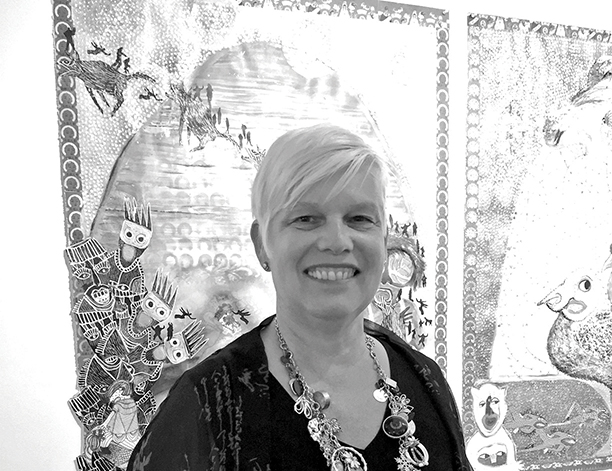Deb Mell

Luminous strands of foot-high blue hair catch the eye. The loosely styled shapes echo wisps of floating sea weed, or Medusa, a winged, mythological figure who turned onlookers to stone. Keeping in mind the dry wit associated with multi-media artist Deb Mell, the cobalt blues can be read as a winking homage to bad-boy punk bands, the kind that enter an arena with a ringing chord. Mell’s three-dimensional pieces, and her collaged paintings, grab your attention: they transform a space by sheer gumption, and ultimately, the art-historical sophistication of their effect.
She welcomes this visitor on a brisk winter afternoon to her home, an oasis of natural light set on a forested hill in Truro, MA. Mell, a master of fabrication techniques, describes her painstaking additive process, where beads, buttons, sequins, paint, natural objects and more meld in dazzling intricacy. “I enjoy making the art,” Mell begins. “Art is like air to me. I need the art to breathe.” In the dining area, a beaded chair sparkles in the sun. Abandoned in the local “sanitary landfill,” a magnet for makers known colloquially as the dump, what was a throw-away is now a conversation piece.
During the isolation of the pandemic, Mell had time to upcycle the wooden object, with its high back and wide arms. Using beads stashed away from other projects, she turned it into an Egyptian-style throne. “The physical making is the most important part to me,” she continues. “And I’m always thinking of even more complicated pieces. A recent piece had six thousand beads. I attached them, one by one.”
Leading the way to her basement studio, we stop to look at a wall-hanging, beaded portrait, Hands, of an androgynous saint. Gloves hang over the frame, morphing into feet, or howling wolves. Entering the packed studio space, Mell describes her recent creative journey, from the colors inspired by the bay and ocean of the Outer Cape to the sparkle and sheen of white, in all its intriguing variations.

Incorporating a modeling material of paper and clay to replace hard-to-get beads, the use of white signifies a partial jump back to the allure of minimalism. Mell shows how sensitively she manipulates a limited color palette to maximum effect in Double Super-Secret. Two figures share an affectionate greeting. The black and white bear-like figure, torso covered with Mell’s hand-made, black and white rosettes, is crowned with red
ornaments. Glancing down, the gentle creature reaches out to a masked figure, whose white gown is accented in black, and whose head is topped, in a marriage of wit and ingenuity, with a bird’s nest.
Mell’s art continues to incorporate this maker’s beginnings: in art school, she was influenced by the Pattern and Decoration movement of the 1970s, typified by practitioners Joyce Kozloff and Miriam Shapiro, two feminist creators. The mantra “more is never enough” remains a connecting through line.
The bejeweled, six-foot totem piece, Mr. Doo Bee, exhibited recently at the Berta Walker Gallery, Provincetown, MA, is crowned with the Medusa torso, whose wings float below scale-like arms, ending in blue fingers. These hands, so doll-like with their chubby fingers, were sourced from an actual doll. Mell is fascinated by doll parts. She uses dolls’ heads as sculptural ready-mades, and has “planted” them as garden ornaments. Doll feet, with stubby toes, also appear in this piece. But cuteness is hardly the point: behind the storybook façade looms Mell’s wickedly playful sense of humor.

Perched below the torso is a flying object with a polka-dotted red mask; then a rooster-like pillow, and a red rooster, whose orange-flecked, phallic beak dominates a frontal view. What of the dozens of white rosettes and mini-leaves? Mell shaped these from the paper clay, deploying, in perhaps another commentary on conventional women’s roles, little butter molds.
“My kids call me MacGyver,” Mell says, referring to the television character known for repurposing promising materials. The word “femmage” has been used to define techniques and objects associated with women, hence not considered “high art.” Gull feathers, birds’ nests, bones, teeth, gloves, beads, sequins, paper clay rolled and molded using kitchen supplies—a plethora of objects can wind up on Mell’s palette, awaiting transformation. “I just sort of make things,” she says modestly, “and don’t worry about categories.”
